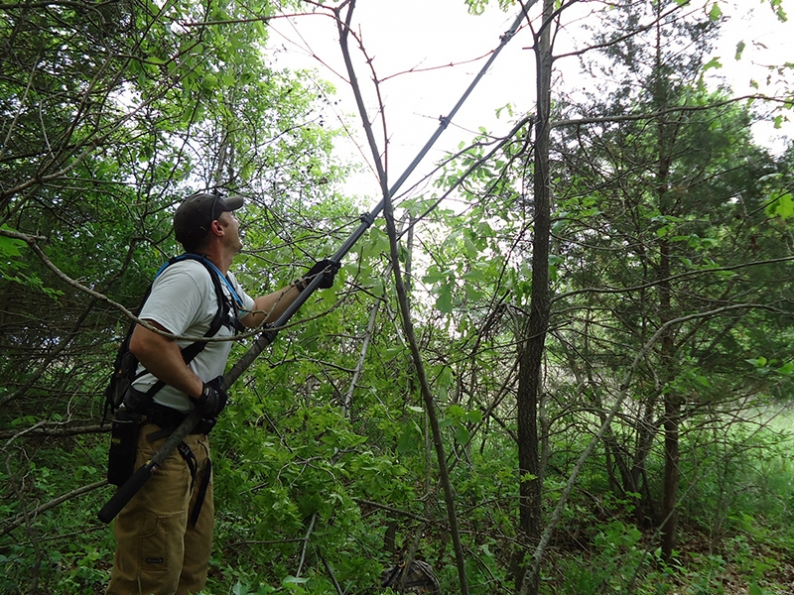
Ten vegetation-taming tips for deer hunters
As you read these words, summer’s lush, green growth is wrapping itself around your hunting stands and ground blind locations. Now is the time to begin thinking about trimming limbs, branches and brush that might otherwise interfere with a successful hunt this fall.
Of course, there’s a right way and a wrong way to do almost anything. Follow these ten tips for productive and prudent pruning.
Safety first
Trimming elevated vegetation is inherently dangerous. Always wear a safety harness while trimming from an elevated location. Wear proper protective clothing including safety glasses, gloves and chaps if trimming with a chainsaw. Bring a buddy in case there are any emergencies.
Bring the right tools
The vast majority of all trimming jobs are adequately conducted with a quality limb saw and a pair of pruning shears. Ratcheting shears, a long-handled lopper, and a limb saw with a long, telescoping handle can often make things easier. In some cases, a ladder may also be required. Use your buddy to steady your ladder while climbing.
Trim early and often
Most vegetation will be fully developed by mid-summer. But just because you trim now doesn’t mean your hunting sites won’t require some additional attention before hunting begins. Carry a small, folding limb saw and a pair of pruning shears with you whenever you head to your stands prior to and during hunting season.
Plan your ingress and egress
Consider the prevailing winds, and then plan primary and secondary routes to and from each stand or blind location. Once you identify your routes, clean a trail into your stand sites. You can reduce the odds of bumping deer by taking time to clear your paths of sticks you might step on or noisy brush that may snag you or your gear.
Clear the climb
Remove enough brush at the base of each ladder stand, treestand, or ground blind entrance to remain quiet during entry and exit. Also trim any branches or twigs that you might brush up against and create noise while climbing in or out of your stands.
Clear shooting lanes
Sit in your stand or blind and try to draw your bow or shoulder your gun in the directions you believe deer are most likely to appear, then cut away any limb or twig that might contact you, your gun barrel, arrow or bow – including the small stuff that might get caught between your cam and bow string. While still in the stand, identify any major limbs that might deflect your arrow or bullet on the way to its target and do your best to eliminate those as well. Think seriously about shooting lanes. Our initial thoughts on the places we believe shot opportunities will occur are often dead wrong. Think about the bucks you’ve observed approaching a field or food plot. Did they stroll up the trail and stop at the very edge? Rarely. Recall past encounters and you’ll realize that bucks typically stop well short of those defined edges, remaining close to the comfort of thick cover as they scent check and look for other deer. Mature bucks also rarely use the main deer trails used by does and yearlings, preferring to stay just downwind of those primary trails during travel. Look for windows five to ten yards back from field and clearing openings and primary trails, then clear appropriate shooting lanes.
Don’t over-trim
Cutting brush and limbs in and around your stands and blinds is important, but don’t overdo it. You’ll want to leave some vegetation for concealment, especially around the bottom of the stand and your lower body. Try to picture what your stand will look like once the trees drop their leaves in the fall, then trim accordingly. You can always remove more later.
Prepare ground blind locations
In addition to trimming relative to ingress/egress and shooting lanes, portable ground blind sites require additional considerations. Clear the ground where any portable ground blind will be placed of any sticks, brush or leaf litter that may produce noise once hunting begins.
Keep camera sets clear
Stand sites and shooting lanes are obvious trimming priorities, but don’t neglect your camera sites. Limbs, grasses or other vegetation within your camera’s field of view can sway in the wind and trigger the shutter, resulting in an annoying abundance of worthless images and reduced battery life.
Don’t leave a noisy mess
Trimmed limbs and twigs shouldn’t be left to lie on the ground, as they may be stepped on and alert deer. Instead, use them for extra concealment around the lower portion of your stand or around the outside of your blind.